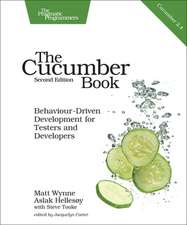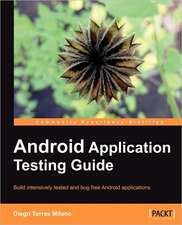Android Espresso Revealed: Writing Automated UI Tests
Autor Denys Zelenchuken Limba Engleză Paperback – mar 2019
Write Android user interface (UI) tests using Google Espresso for Android. You’ll cover all the major topics of writing functional UI automated tests using the Espresso testing framework, including different ways of running automated tests, architecting test projects in an easy and maintainable way, and using tools which help to implement automated tests with less effort.
Android Espresso Revealed explains the basics of using Espresso to write automated UI tests, and how to customize the framework for advanced functionality. The author provides examples in both Java and Kotlin, and includes dealing with network operations in UI tests, testing application accessibility, implementing supervised monkey tests, and more.
What You Will Learn
- Write Espresso tests with both Kotlin and Java including test project migration from Java to Kotlin
- Test web views inside the application undertest
- Use Espresso to set up test devices or emulators to minimize test flakiness and run tests in Firebase Test Lab
- Verify and stub intents with Espresso-Intents
- Move test projects to AndroidX
- Test notifications or operate on third-party apps during Espresso test execution
- Apply different test architecture approaches to the test project to reduce maintenance effort
- Implement supervised monkey tests using Espresso and UIAutomator
Who This Book Is For
Engineers with experience of Android test automation will benefit from this book
Preț: 295.63 lei
Preț vechi: 369.53 lei
-20% Nou
Puncte Express: 443
Preț estimativ în valută:
52.31€ • 61.34$ • 45.94£
52.31€ • 61.34$ • 45.94£
Carte disponibilă
Livrare economică 14-28 ianuarie 26
Preluare comenzi: 021 569.72.76
Specificații
ISBN-13: 9781484243145
ISBN-10: 1484243145
Pagini: 185
Ilustrații: XVII, 308 p. 99 illus.
Dimensiuni: 178 x 254 mm
Greutate: 0.57 kg
Ediția:1st ed.
Editura: Apress
Colecția Apress
Locul publicării:Berkeley, CA, United States
ISBN-10: 1484243145
Pagini: 185
Ilustrații: XVII, 308 p. 99 illus.
Dimensiuni: 178 x 254 mm
Greutate: 0.57 kg
Ediția:1st ed.
Editura: Apress
Colecția Apress
Locul publicării:Berkeley, CA, United States
Cuprins
1. Getting started with Espresso for Android.- 2. Customizing Espresso for Our Needs.- 3. Writing Espresso Tests with Kotlin.- 4. Handling network operations or long-lasting actions.- 5. Verifying and stubbing intents with IntentMatchers.- 6. Testing web views.- 7. Accessibility testing.- 8. Espresso and UIAutomator.- 9. Dealing with runtime system actions and permissions.- 10. Test automation tooling.- 11. Screen Object Design Pattern in Android UI tests.- 12. Testing Robot Patterns with Espresso and Kotlin.- 13. Supervised Monkey Tests with Espresso and UI Automator.- 14. AndroidX Test Library.- 15. Improving Productivity and Testing Unusual Components.
Notă biografică
Denys Zelenchuk's professional career as Test Engineer started in Poland in 2010. Starting from 2011, he has been involved in testing mobile applications. He was working at companies like Tieto Poland, XING (Hamburg, Germany) and currently is working and living in Zurich Switzerland in Numbrs Personal Finance AG company. As of October 2013, he's been using Espresso for Android test automation framework to write automated tests.
Textul de pe ultima copertă
Write Android user interface (UI) tests using Google Espresso for Android. You’ll cover all the major topics of writing functional UI automated tests using the Espresso testing framework, including different ways of running automated tests, architecting test projects in an easy and maintainable way, and using tools which help to implement automated tests with less effort.
Android Espresso Revealed explains the basics of using Espresso to write automated UI tests, and how to customize the framework for advanced functionality. The author provides examples in both Java and Kotlin, and includes dealing with network operations in UI tests, testing application accessibility, implementing supervised monkey tests, and more.
You will:
- Write Espresso tests with both Kotlin and Java including test project migration from Java to Kotlin
- Test web views inside the application under test
- Use Espresso to set up test devices or emulators to minimize test flakiness and run tests in Firebase Test Lab
- Verify and stub intents with Espresso-Intents
- Move test projects to AndroidX
- Test notifications or operate on third-party apps during Espresso test execution
- Apply different test architecture approaches to the test project to reduce maintenance effort
- Implement supervised monkey tests using Espresso and UIAutomator
Caracteristici
A concise primer on an industry standard UI testing tool for Android developers Covers both Java and Kotlin code, appropriate to today's Android developers Author is an industry experienced expert at using Google Espresso for Android



















